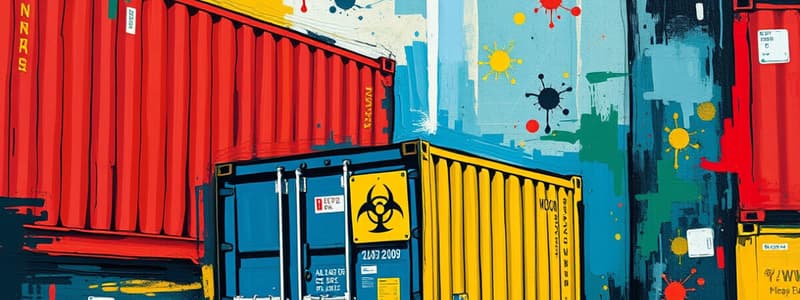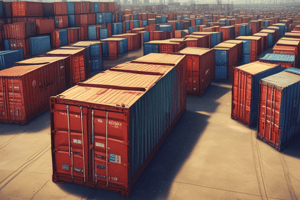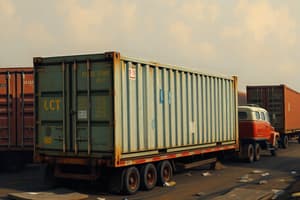Podcast
Questions and Answers
What is the primary function of 331 pressure cargo tankers?
What is the primary function of 331 pressure cargo tankers?
- Maintaining stability for dry bulk powders
- Carrying substances that can cause explosions when exposed to fire (correct)
- Transporting food products at standard temperatures
- Holding large volumes of non-flammable liquids
Which type of tanker is designed to transport powders and pellets using pressure for offloading?
Which type of tanker is designed to transport powders and pellets using pressure for offloading?
- Pressure cargo tankers
- Tube trailers
- Dry bulk cargo tanks (correct)
- Cryogenic tankers
What is the typical capacity of 307/407 tankers?
What is the typical capacity of 307/407 tankers?
- 5,000 to 6,000 gallons
- 6,000 to 7,000 gallons (correct)
- 7,000 to 10,000 gallons
- 10,000 to 12,000 gallons
Which tanker type operates at the lowest pressure compared to others?
Which tanker type operates at the lowest pressure compared to others?
What distinguishes tube trailers in terms of gas transport?
What distinguishes tube trailers in terms of gas transport?
Which of the following is classified as a bulk storage vessel?
Which of the following is classified as a bulk storage vessel?
What material is typically NOT used for constructing drums for hazardous materials?
What material is typically NOT used for constructing drums for hazardous materials?
Which statement about non-bulk storage vessels is accurate?
Which statement about non-bulk storage vessels is accurate?
What is not a characteristic of bulk storage vessels?
What is not a characteristic of bulk storage vessels?
Which type of storage vessel is generally used for transporting gases?
Which type of storage vessel is generally used for transporting gases?
What defines an intermodal tank?
What defines an intermodal tank?
Which hazardous materials storage option is made specifically for corrosive substances?
Which hazardous materials storage option is made specifically for corrosive substances?
Which feature is generally not associated with large horizontal tanks used for storage?
Which feature is generally not associated with large horizontal tanks used for storage?
Flashcards are hidden until you start studying
Study Notes
Types of Containers for Hazardous Materials
- Containers are vessels that hold hazardous substances; their type, size, and material indicate content nature.
- Color of containers (e.g., drums) does not correlate with specific contents.
Bulk vs. Non-Bulk Storage Vessels
- Bulk storage vessels include fixed tanks, cargo tanks, rail tank cars, totes, and intermodal tanks.
- Non-bulk storage vessels hold from a few ounces up to 119 gallons; they include drums, bags, gas cylinders, and cryogenic containers.
Bulk Storage Vessels
- Fixed tanks and cargo tanks store large quantities and often incorporate secondary containment to mitigate spills.
- Large horizontal tanks (aboveground or underground) hold hundreds to millions of gallons, constructed from aluminum, steel, or plastic.
- Totes (intermediate bulk containers) hold 119 to 793 gallons, are portable, and have a stainless steel webbing but lack secondary containment.
- Intermodal tanks can hold 5,000 to 6,000 gallons and can be pressurized or non-pressurized for multi-modal transport.
Non-Bulk Storage Vessels
- Drums can be made of low-carbon steel, polyethylene, cardboard, stainless steel, or nickel to store various materials.
- Construction of drums is specific to the contents (e.g., polyethylene for corrosives, stainless steel for aggressive chemicals).
- Bags store solids or powders, made of plastic or paper and must include detailed labeling, including hazard statements and storage instructions.
- Carboys (5-15 gallons) store corrosive substances and are often protected by boxes of wood, foam, or fiberglass.
- Compressed gas cylinders vary in size for transporting gases, with hazardous materials marked clearly.
Overland Transport Methods
- Cargo tanks designed for transporting hazardous materials are bulk packages that can be loaded or unloaded without removal from vehicles.
- Common types include 306/406 (non-pressurized, flammable liquids, 6,000 to 10,000 gallons) and 307/407 (round/horse-shaped, 6,000 to 7,000 gallons, mild corrosives).
Specific Tanker Types
- 312/412 tanks are smaller in diameter with reinforcing rings for stability, holding about 6,000 gallons, operating at 15 to 35 PSI.
- 331 pressure cargo tankers carry substances like ammonia and operate at approximately 300 PSI with explosion hazards if exposed to fire.
- 338 cryogenic tankers maintain low temperatures for cryogens and vent vapor as normal operations.
- Tube trailers transport several compressed gases (like hydrogen and oxygen) at high pressures (3,000 to 5,000 PSI), with individual relief valves.
- Dry bulk cargo tanks transport powders and pellets, utilizing pressure for offloading, with v-shaped containers for stability.
Types of Containers for Hazardous Materials
- Containers serve as vessels for hazardous substances; their types, sizes, and materials reveal the nature of their contents.
- Container color (e.g., drums) doesn't specifically indicate their contents.
Bulk vs. Non-Bulk Storage Vessels
- Bulk storage vessels include fixed tanks, cargo tanks, rail tank cars, totes, and intermodal tanks.
- Non-bulk storage vessels range from a few ounces to 119 gallons and consist of drums, bags, gas cylinders, and cryogenic containers.
Bulk Storage Vessels
- Fixed and cargo tanks are designed for large quantities and usually have secondary containment features to prevent spills.
- Large horizontal tanks, whether aboveground or underground, can hold from hundreds to millions of gallons and are made from materials like aluminum, steel, or plastic.
- Totes, or intermediate bulk containers, can carry 119 to 793 gallons, are portable, but typically lack secondary containment; they are reinforced with stainless steel webbing.
- Intermodal tanks have capacities ranging from 5,000 to 6,000 gallons and can be pressurized or non-pressurized, facilitating multi-modal transport.
Non-Bulk Storage Vessels
- Drums are made from materials such as low-carbon steel, polyethylene, cardboard, stainless steel, or nickel, tailored to the type of material stored.
- Specific drum construction is linked to the contents: polyethylene for corrosives, stainless steel for aggressive chemicals.
- Bags, made of plastic or paper, are designated for solids or powders and must feature clear labeling that includes hazard statements and storage instructions.
- Carboys, with capacities of 5 to 15 gallons, are used for corrosive substances and come protected in wooden, foam, or fiberglass boxes.
- Compressed gas cylinders vary in size for gas transport, with clear markings for hazardous materials.
Overland Transport Methods
- Cargo tanks meant for hazardous materials are bulk packages that can be loaded or unloaded without detachment from vehicles.
- Common cargo tank types include:
- 306/406 tanks for flammable liquids, non-pressurized, with capacities between 6,000 to 10,000 gallons.
- 307/407 tanks designed for mild corrosives, round or horse-shaped, holding 6,000 to 7,000 gallons.
Specific Tanker Types
- 312/412 tanks feature a smaller diameter and reinforcing rings for stability, typically holding around 6,000 gallons while operating at 15 to 35 PSI.
- 331 pressure cargo tankers transport substances such as ammonia, functioning at about 300 PSI, posing explosion risks when exposed to fire.
- 338 cryogenic tankers maintain low temperatures for cryogenic substances and vent vapor as part of their normal operation.
- Tube trailers are designed to transport various compressed gases (like hydrogen and oxygen) at high pressures between 3,000 to 5,000 PSI, featuring individual relief valves.
- Dry bulk cargo tanks, utilized for transporting powders and pellets, use pressure for offloading and are designed with V-shaped containers for added stability.
Studying That Suits You
Use AI to generate personalized quizzes and flashcards to suit your learning preferences.




